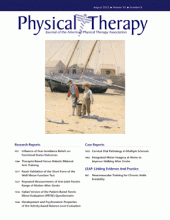Abstract
Background Goniometric measurements of hemiplegic arm joints must be reliable to draw proper clinical and scientific conclusions. Previous reliability studies were cross-sectional and based on small samples. Knowledge about the contributions of sources of variation to these measurement results is lacking.
Objective The aims of this study were to determine the interobserver reliability of measurements of passive range of motion (PROM) over time, explore sources of variation associated with these measurement results, and generate smallest detectable differences for clinical decision making.
Design This investigation was a measurement-focused study with a longitudinal design, nested within a 2-arm randomized controlled trial.
Methods Two trained physical therapists assessed 7 arm movements at baseline and after 4, 8, and 20 weeks in 48 people with subacute stroke using a standardized protocol. One physical therapist performed the passive movement, and the other read the hydrogoniometer. The therapists then switched roles. The relative contributions of several sources of variation to error variance were explored with analysis of variance.
Results Interobserver reliability coefficients ranged from .89 to .97. The PROM measurements were influenced by error variance ranging from 31% to 50%. The participant × time interaction made the largest contribution to error variance, ranging from 59% to 81%. Smallest detectable differences were 6 to 22 degrees and were largest for shoulder movements.
Limitations Verification of shoulder pain and hypertonia as sources of error variance led to a substantial number of unstable variance components, necessitating a simpler analysis.
Conclusions The assessment of PROM with a standardized protocol, a hydrogoniometer, and 2 trained physical therapists yielded high interobserver reliability indexes for all arm movements. Error variance made a large contribution to the variation in measurement results. The resulting smallest detectable differences can be used to interpret future hemiplegic arm PROM measurements with more confidence.
Footnotes
Mr de Jong and Dr Postema provided concept/idea/research design and fund procurement. All authors provided writing and data analysis. Mr de Jong provided data collection and project management. Dr Dijkstra and Dr Postema provided institutional liaisons. The authors thank all of the study participants. Special thanks go to observers Ank Mollema and Marian Stegink.
This study was approved by the Medical Ethics Committee of the University Medical Center Groningen (project METc 2008.107).
This study was funded by a grant from Fonds Nuts Ohra (main study, project SNO-T-0702-72) and Stichting Beatrixoord Noord-Nederland.
The main randomized controlled trial is registered at the Dutch Trial Register (Unique Identifier: NTR1748) (available at: http://www.trialregister.nl/trialreg/index.asp).
- Received September 1, 2011.
- Accepted April 27, 2012.












